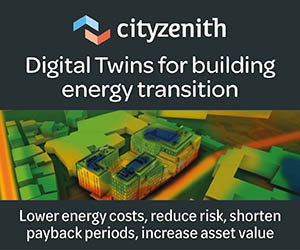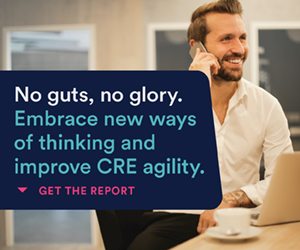Data and Powerful Computing: A Stage for a Symphony

Positioned at the leading edge of technological innovation, artificial intelligence (AI) is seeing increased adoption across businesses and industries. While commercial real estate is no exception, many owners remain unsure how to develop a viable AI strategy that drives outperformance for their companies. As the volume of actionable data grows, however, so too will the timbre of the AI discussion.
At Carr Properties, we are in the first movement of the symphony. Not only is the technology wide-ranging and disparate, but the data to which we're applying it comes in many different types, formats and purposes, as well as from increasingly non-traditional sources.
Our challenge is to take the discordant data and harmonize it. It is the AI applications tasked with processing, storing and delivering the data that make up the orchestra.
Assembling the Instruments
The data that our CRE organizations collect are for answering the 5Ws (who, what, where, when and why) for customer service and property operations. We (as IT) answer the companion question - how - by automating IT processes in a way that lets us use the data to optimize our operations.
It all begins with increasing the power and connectivity of the devices that collect data (computers and Internet-connected "smart" devices alike), as well as increasing the ability of servers and similar machines to automate data extraction, processing and delivery to applications. Like any orchestra, these players - including analytics visualizers, automation tools and machine learning - require coordination and interoperability to deliver crisp "musical" value to the real estate owner. Over time, machines learn, output becomes accurate and valuable, and the stage is set for beautiful music.
Key players include:
Data Extraction: The Percussion Section
Percussion forms the foundation of an orchestra. It sets the rhythm, the standard for time and synchronization, to which the rest of the elements work. Data extraction from all endpoint systems is what sets the schedule and process - the rhythm - for the symphony of information to come.
Modeling: The Brass Section
The brass section of an orchestra enhances the music by giving it volume and robustness, thus creating the sense of spirit and soul. Similarly, the data modeling process enhances our data, giving it strength and dimension that allows it to achieve value across datasets and types. With modeling in place, access control now talks to maintenance; IAQ now talks to BMS. The data is interconnected, hence more robust, and provides insights that enable spirit and soul.

Visualization: The String Section
The string instruments create a sense of form. String players use a balance of precise finger placement and careful bow work to contour the music into something elegant and comprehensible that can draw the listener's ear. Of course, visualization draws the eye rather than the ear. The effect, however, is the same: the visualization phase shapes data from tables into forms that bring them to life and let the beholder make sense of them.
Presentation: The Woodwind Section
Woodwinds offer the music harmony and depth through the players' attention to intricate details - breath, movement of air, mouth and finger techniques - that determine how their musical parts are articulated to produce articulation and presentation of the data. AI's presentation of data does the same: it focuses on the details in order to provide a clearer, deeper understanding of the information on display.
Machine Learning: The Conductor
This role is a self-explanatory one. The automation and machine-learning components of AI conduct the data through the process that interprets the information as orchestrated music.

Getting in Tune
Once all the pieces of the orchestra are in place, the next step is to tune up, allowing the orchestra to work more efficiently.
In the case of CRE, the AI "orchestra" is getting the data systems and the data itself into tune. The current state of development in both the CRE industry and its technology has exposed certain dissonances in data and its collection. For example, understanding if a customer is happy from raw work order data is imperfect, difficult, and requires much human intervention to become valuable information. The use of AI, however, can transform these dissonances into opportunities for the CRE industry to find new areas of efficiency and harmony.
Legacy Systems
This digital-age technology has to be applied to data systems that are decidedly less cutting edge. From handwritten notes and printed paper forms to systems that we built before cloud services gained popularity, like EMS and BMS, the systems as well as the data can often seem incompatible. It is through automation and machine-learning capabilities (extracting, modeling, correlation, predictive intelligence) that we are able to make this information actionable and find new insights in old data.
Many Stakeholders
More and more parts of CRE are tasked with analyzing data. Asset managers widely query lease clauses for exclusion rights; building operations look at amenity usage to understand customer satisfaction. These different segments of the industry collect and prioritize different types of data. AI technologies can create uniform data models that organize all of that diverse information and establish new correlations among datasets.
Massive, Decentralized Data
The diversity of systems and stakeholders, combined with other factors, has long meant that datasets lived in silos with limited access and even less interconnection. Yet more recent technologies have made this extensive data accessible and easy to aggregate, using AI to find and establish common data elements that it can relate across datasets and types.
Keeping Cadence
Understanding the data symphony and the part we play in it means understanding what is happening around us. So, why is AI particularly relevant in this moment for CRE?
Growing Iot Presence
The explosion of Internet-connected "smart" hardware in our properties (gym equipment, counting cameras, air quality sensors, etc.) has increased the volume, sources and richness of the data we collect. These distributed systems make any real estate operator rich in data - and in need of equally rich data analysis.
Cost-Reduction Considerations & IAQ Programs
With the return-to-work initiative emerging from the pandemic, along with general market pressures, companies need to achieve efficiencies wherever possible. Data analytics and AI can help operators understand occupancy trends and make changes to costly services.
Increased Expertise
As companies invest in IT innovation teams and technology incubation labs, the demand for skilled IT professionals is only growing. Fortunately, the supply is keeping pace with demand, as more people in the job market have the skills to execute these initiatives.
Bravissimo
Just as music has real health benefits, the symphony Carr Properties is orchestrating with AI applications like automation and machine learning, has tangible business benefits. Carr has already seen successful results in our early efforts and been able to take that cacophony of disparate, disorganized, disjointed data and orchestrate it into an elegant symphony.
We are using the newly harmonious data to better understand customer sentiment, lease renewal rates, and overall satisfaction with us as their landlord. More than just improving our customer service, however, we are increasingly able to reduce costs and improve efficiencies, and even to author smart building activities based on the data we’re using AI to extract, analyze, and model. Our understanding of both the data and of the value AI adds to our business is only improving as we move forward.
The results we've achieved are only scratching the surface of what is possible and of what's to come. If what we've described above compares to an elegant symphony, just imagine what the music of tomorrow will offer.
This year's conference will present industry topics on technology and innovation, such as AI, digital twins and many other topics presented by thought leaders. Realcomm | IBcon 2021 will be held at the Westin Kierland Resort in Scottsdale on Nov. 2-3 (Oct. 31: Golf Outing & Sports Activities | Nov. 1: Precon). Register today!
This Week’s Sponsor
Angus Systems is a leading provider of customer driven mobile and cloud-based work order and operations management solutions for commercial real estate. Our software supports over 2.6 billion square feet across North America in buildings from 20,000 to portfolios of more than 100 million square feet. Visit www.angus-systems.com to learn how we help our clients shine.
Read Next
 5/15/2025
5/15/2025
Tech, Talent and Transformation: 2025 Digie Finalists Announced For 27 years, Realcomm has presented the Digie Awards to acknowledge companies, real estate projects, technologies, and individuals that have advanced the commercial real estate industry through the strategic use of technology, automation, and innovation.
 5/15/2025
5/15/2025
Empowering Space Management with Data-Driven Visualization For effective CRE space management, it’s critical to centralize lease data, maximize rental square footage (RSF), improve energy efficiency and reconfigure spaces to meet changing needs.
 5/8/2025
5/8/2025
The AI-Powered Workplace Evolution: Redefining the Business Landscape In today's rapidly evolving business environment, the fusion of Artificial Intelligence (AI) and Workplace Management is revolutionizing the way organizations approach workspace optimization and operational efficiency.
 3/27/2025
3/27/2025
The Convergence of Edge Computing, Cloud, and AI in Building Automation and Smart Buildings In the built environment, we have seen the convergence of Operational Technology (OT) and Information Technology (IT), later expanding to include Workplace Technologies (WP).





%20(1)%20(1)%20(1).png)







